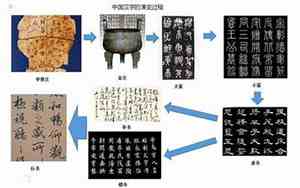中国汉字的演变过程及特点

中国汉字,是世界上最古老的文字之一,其演变过程漫长而丰富,见证了中华文明的深厚底蕴。汉字的起源可以追溯到新石器时代的甲骨文,大约在公元前14世纪至公元前11世纪的商朝时期。最初的汉字是象形文字,通过简单的图画来代表实物,如"日"字就像太阳,"山"字就像山峰。
到了商朝晚期,汉字开始发展为更加成熟的图形符号,即甲骨文,文字形状更加规则,结构也更为复杂。到了周朝,金文出现,主要刻在青铜器上,字形更加规范化,同时出现了早期的简化字。
秦朝统一六国后,推行了小篆,这是汉字发展史上的一个重要转折点,小篆在笔画和结构上更为统一,对后世影响深远。汉朝时期,隶书出现,字形进一步简化,书写更加流畅,这是汉字从象形到线条美的过渡阶段。
进入魏晋南北朝,行书和草书兴起,更加注重速度和美感,成为日常书写的主要形式。而到了隋唐时期,楷书成为官方书体,具有严谨的笔画、清晰的结构,流传至今,依然是汉字书写的主要规范。
现代汉字在简化字的基础上,继续进行现代化改革,如简化字运动,使得汉字更加便于阅读和书写。汉字的演变过程体现了中国文化的积累、智慧的结晶和历史的沉淀。
中国汉字的演变过程英语作文
Title: The Evolution of Chinese Characters: A Cultural Reflection
The Chinese writing system, known as Hanzi, is an extraordinary testament to the profound history and evolution of Chinese civilization. With roots dating back to the Neolithic era, these ancient symbols have undergone a fascinating journey that spans thousands of years.
The earliest forms of Chinese characters, such as oracle bone script (Oracle Bone Inscriptions, ca. 14th-11th century BC), were primarily pictographic, representing objects and concepts through drawings. Over time, they developed into the Oracle Bone and Bronze Inscriptions, which featured more standardized shapes and a clearer connection to their original meanings.
During the Shang and Zhou dynasties, the seal script emerged, followed by the more refined and concise clerical script (秦小篆, ca. 3rd century BC) during the Qin Dynasty. The latter was a major milestone, as it introduced a consistent style, particularly under Emperor Qin Shi Huang.
The Han Dynasty saw the transition to the popular script of the time, the clerical script, and later, the elegant and flowing running script (行书) and cursive script (草书) emerged during the Wei and Jin periods, reflecting a focus on speed and artistic expression.
The standardized script we know today, the楷书 (ca. 6th-9th century AD), was developed in the Tang Dynasty.楷书因其清晰的笔画和 balanced structure became the standard for official documents and remains so to this day.
Modern Chinese characters, though simplified through the Simplified Chinese movement, retain a deep historical connection. This evolution not only demonstrates the adaptability of the Chinese language but also underscores the continuous evolution of Chinese culture.
In conclusion, the evolution of Chinese characters is a vivid narrative of the country's past, reflecting changes in society, technology, and aesthetics. Each stage of this development mirrors the perseverance and creativity of the Chinese people, Chinese writing an enduring symbol of Chinese civilization.


